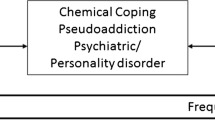Abstract
Treatment of pain first requires an accurate measurement of pain. Though complex and multifactorial, it is based on two overarching concepts: qualifying and quantifying pain. In practicality, this information is obtained from the subjective report of pain by a patient and/or the use additional validated tools for measuring pain. Radiological or laboratory studies are limited in that they may only evaluate underlying pathology. Thus, it is vital for a physician to adequately measure a patient’s pain to provide effective and timely treatments and to avoid unnecessary medications and procedures. The ultimate goal would be the improvement in quality of life of a patient. Measurement of pain in pediatric as well as adult population is discussed.
Access this chapter
Tax calculation will be finalised at checkout
Purchases are for personal use only
Similar content being viewed by others
References
Tomlinson D, von Baeyer CL, Stinson JN. A systematic review of faces scales for the self-report of pain intensity in children. Pediatrics. 2010;126(5):e1168–98.
Beyer JE, McGrath PJ, Berde CB. Discordance between self-report and behavioral pain measures in children aged 3–7 years after surgery. J Pain Symptom Manage. 1990;5(6):350–6.
Stevens B, Johnston C, Petryshen P, Taddio A. Premature infant pain profile: development and initial validation. Clin J Pain. 1996;12(1):13–22.
Lawrence J, Alcock D, McGrath P, et al. The development of a tool to assess neonatal pain. Neonatal Netw. 1993;12(6):59–66.
Grunau RE, Oberlander T, Holsti L, Whitfield MF. Bedside application of the Neonatal Facial Coding System in pain assessment of premature neonates. Pain. 1998;76(3):277–86.
Hummel P, Puchalski M, Creech SD, Weiss MG. Clinical reliability and validity of the N-PASS: neonatal pain, agitation and sedation scale with prolonged pain. J Perinatol. 2008;28(1):55–60.
Krechel SW, Bildner J. CRIES: a new neonatal postoperative pain measurement score. Initial testing of validity and reliability. Paediatr Anaesth. 1995;5(1):53–61.
van Dijk M, Roofthooft DW, Anand KJ, et al. Taking up the challenge of measuring prolonged pain in (premature) neonates: the COMFORTneo scale seems promising. Clin J Pain. 2009;25(7):607–16.
Carbajal R, Veerapen S, Couderc S, et al. Analgesic effect of breast feeding in term neonates: randomised controlled trial. BMJ. 2003;326:13.
Holsti L, Grunau RE. Initial validation of the Behavioral Indicators of Infant Pain (BIIP). Pain. 2007;132(3):264–72.
Debillon T, Zupan V, Ravault N. Development and initial validation of the EDIN scale, a new tool for assessing prolonged pain in preterm infants. Arch Dis Child Fetal Neonatal Ed. 2001;85(1):F36–41.
Wong-Baker FACES Foundation. Wong-Baker FACES® Pain rating scale. 2017. Retrieved 3 Oct 2017. http://www.WongBakerFACES.org wpf.
Wong DL, Baker CM. Pain in children: comparison of assessment scales. Pediatr Nurs. 1988;14(1):9–17.
WHO guidelines on the pharmacological treatment of persisting pain in children with medical illnesses. http://apps.who.int/medicinedocs/documents/s19116en/s19116en.pdf:26-35.
Hicks CL, von Baeyer CL, Spafford P, et al. Faces pain scale-revised: toward a common metric in pediatric pain measurement. Pain. 2001;93(2):173–83.
Beyer JE, Denyes MJ, Villarruel AM. The creation, validation, and continuing development of the Oucher: a measure of pain intensity in children. J Pediatr Nurs. 1992;7(5):335–46.
Hamill JK, Lyndon M, Liley A, et al. Where it hurts: a systematic review of pain-location tools for children. Pain. 2014;155(5):851–8.
Malviya S, Voepel-Lewis T, Burke C, et al. The revised FLACC observational pain tool: improved reliability and validity for pain assessment in children with cognitive impairment. Paediatr Anaesth. 2006;16(3):258–65.
Voepel-Lewis T, Merkel S, Tait AR, et al. The reliability and validity of the Face, Legs, Activity, Cry, Consolability observational tool as a measure of pain in children with cognitive impairment. Anesth Analg. 2002;95(5):1224–9.
Breau LM, McGrath PJ, Camfield CS. Psychometric properties of the non-communicating children’s pain checklist-revised. Pain. 2002;99(1–2):349–57.
Hunt AM. A survey of signs, symptoms and symptom control in 30 terminally ill children. Dev Med Child Neurol. 1990;32(4):341–6.
Hunt A, Burne R. Medical and nursing problems of children with neurodegenerative disease. Palliat Med. 1995;9(1):19–26.
Solodiuk J, Curley MA. Pain assessment in nonverbal children with severe cognitive impairments: the Individualized Numeric Rating Scale (INRS). J Pediatr Nurs. 2003;18(4):295–9.
Suzuki T. Does the combination use of two pain assessment tools have a synergistic effect? J Intensive Care. 2017;5:1.
Aitken RC. Measurement of feelings using visual analogue scales. Proc R Soc Med. 1969;62(10):989–93.
Hawker GA, Davis AM, French MR, et al. Development and preliminary psychometric testing of a new OA pain measure–an OARSI/OMERACT initiative. Osteoarthr Cartil. 2008;16(4):409–14.
Melzack R. The McGill Pain Questionnaire: major properties and scoring methods. Pain. 1975;1(3):277–99.
Melzack R. The short-form McGill Pain Questionnaire. Pain. 1987;30(2):191–7.
Ngamkham S, Vincent C, Finnegan L, et al. The McGill Pain Questionnaire as a multidimensional measure in people with cancer: an integrative review. Pain Manag Nurs. 2012;13(1):27–51.
Lichtner V, Dowding D, Esterhuizen P, et al. Pain assessment for people with dementia. BMC Geriatr. 2014;14:138.
Feldt KS. The checklist of nonverbal pain indicators (CNPI). Pain Manag Nurs. 2000;1(1):13–21.
Author information
Authors and Affiliations
Editor information
Editors and Affiliations
Rights and permissions
Copyright information
© 2019 Springer Nature Switzerland AG
About this chapter
Cite this chapter
Patel, V.B., DeZure, C.P. (2019). Measurement of Pain. In: Abd-Elsayed, A. (eds) Pain. Springer, Cham. https://doi.org/10.1007/978-3-319-99124-5_37
Download citation
DOI: https://doi.org/10.1007/978-3-319-99124-5_37
Published:
Publisher Name: Springer, Cham
Print ISBN: 978-3-319-99123-8
Online ISBN: 978-3-319-99124-5
eBook Packages: MedicineMedicine (R0)




